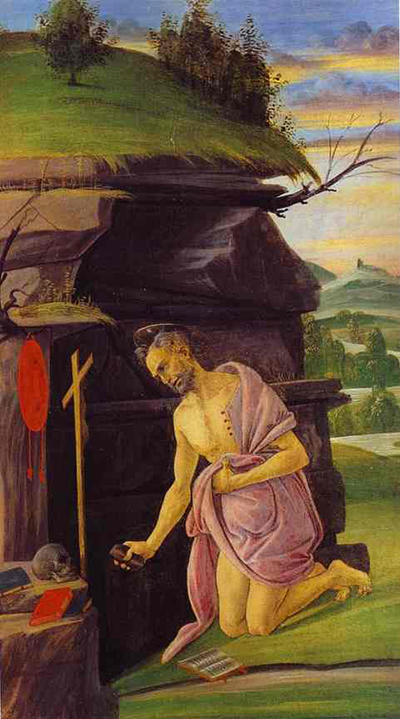St Jerome kneels in a modest fashion within this panel artwork by Sandro Botticelli. It dates from around 1498 - 1505 and is now part of the collection of the Hermitage Museum in Russia, where it is displayed alongside St Dominic.
The saint here is dressed in a simple robe and is pictured alone. He is deep within the countryside, with rolling hills just viewable in the far distance. Botticelli himself was highly skilled in portraiture and took on a variety of different approaches, including simple shoulder length depictions, as well as much more complex figurative work as found here. Some of the angles that he used were rare at that time in the Early Renaissance but would become more common because of his contributions. He also took on non-religious content which widened the scope of his oeuvre and encouraged others to consider challenging themselves more. Eventually patrons would follow suit and allowed all manner of different projects which in turn helped to add interest to the overall direction of the Renaissance.
St Jerome was famous for translating the Bible into Latin, which was an essential contribution to the spread of religion across the various kingdoms of Italy. He was considered more generally to be an extremely learned gentleman and so most depictions of him have placed books within the various compositions. Often he would also be set within his small study, as another way of underlining his identity and role. Some related examples includes St Jerome in His Study (1480) by Domenico Ghirlandaio, St Jerome in the Desert by Giovanni Bellini, Saint Jerome Writing by Caravaggio and also Jerome in the Desert, tormented by his memories of the dancing girls by Francisco de Zurbarán. The list of artists who have included him in their work is literally a whose who of Italian Renaissance art, with a number of others from Spain and the Northern regions also covering him too.
It is rare to find any art from Botticelli within Russia, but the Hermitage have been able to acquire a few of his lesser known artworks over the years. The establishment itself is a must-see for anyone fortunate enough to find themselves in St Petersburg, which itself is a stunning city which boasts a wide variety of cultural pursuits to enjoy. The state collections are so considerable that even some huge buildings across the city are still not able to display all of this great work together at the same time, meaning it is necessary to rotate items from time to time, as well as sometimes loaning them out elsewhere to make sure that as many people can view them as possible.




